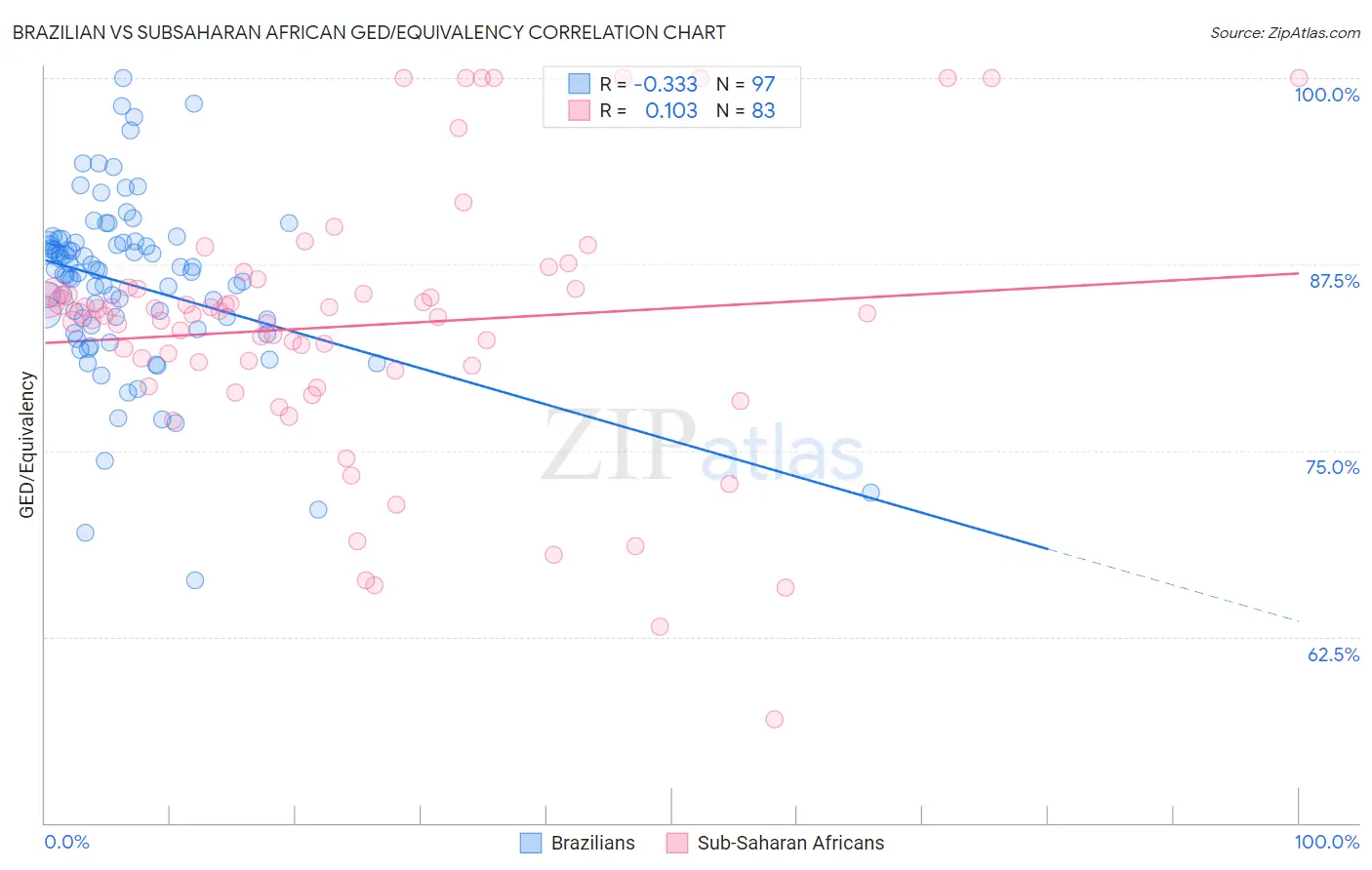Brazilian vs Subsaharan African GED/Equivalency
COMPARE
Brazilian
Subsaharan African
GED/Equivalency
GED/Equivalency Comparison
Brazilians
Sub-Saharan Africans
86.3%
GED/EQUIVALENCY
77.2/ 100
METRIC RATING
152nd/ 347
METRIC RANK
84.2%
GED/EQUIVALENCY
3.0/ 100
METRIC RATING
237th/ 347
METRIC RANK
Brazilian vs Subsaharan African GED/Equivalency Correlation Chart
The statistical analysis conducted on geographies consisting of 323,949,291 people shows a mild negative correlation between the proportion of Brazilians and percentage of population with at least ged/equivalency education in the United States with a correlation coefficient (R) of -0.333 and weighted average of 86.3%. Similarly, the statistical analysis conducted on geographies consisting of 508,215,958 people shows a poor positive correlation between the proportion of Sub-Saharan Africans and percentage of population with at least ged/equivalency education in the United States with a correlation coefficient (R) of 0.103 and weighted average of 84.2%, a difference of 2.5%.

GED/Equivalency Correlation Summary
| Measurement | Brazilian | Subsaharan African |
| Minimum | 66.3% | 56.9% |
| Maximum | 100.0% | 100.0% |
| Range | 33.7% | 43.1% |
| Mean | 86.1% | 83.4% |
| Median | 87.0% | 84.2% |
| Interquartile 25% (IQ1) | 83.3% | 80.4% |
| Interquartile 75% (IQ3) | 89.0% | 85.9% |
| Interquartile Range (IQR) | 5.7% | 5.5% |
| Standard Deviation (Sample) | 5.8% | 8.8% |
| Standard Deviation (Population) | 5.8% | 8.7% |
Similar Demographics by GED/Equivalency
Demographics Similar to Brazilians by GED/Equivalency
In terms of ged/equivalency, the demographic groups most similar to Brazilians are Immigrants from Bosnia and Herzegovina (86.3%, a difference of 0.020%), Kenyan (86.3%, a difference of 0.020%), Armenian (86.3%, a difference of 0.020%), Immigrants from Western Asia (86.3%, a difference of 0.050%), and Immigrants from Poland (86.3%, a difference of 0.060%).
| Demographics | Rating | Rank | GED/Equivalency |
| Pakistanis | 80.4 /100 | #145 | Excellent 86.4% |
| Basques | 79.5 /100 | #146 | Good 86.4% |
| Immigrants | Northern Africa | 79.3 /100 | #147 | Good 86.3% |
| Immigrants | Poland | 79.3 /100 | #148 | Good 86.3% |
| Menominee | 79.3 /100 | #149 | Good 86.3% |
| Immigrants | Western Asia | 78.8 /100 | #150 | Good 86.3% |
| Immigrants | Bosnia and Herzegovina | 77.9 /100 | #151 | Good 86.3% |
| Brazilians | 77.2 /100 | #152 | Good 86.3% |
| Kenyans | 76.6 /100 | #153 | Good 86.3% |
| Armenians | 76.4 /100 | #154 | Good 86.3% |
| Iraqis | 75.2 /100 | #155 | Good 86.2% |
| Immigrants | Nepal | 73.3 /100 | #156 | Good 86.2% |
| Whites/Caucasians | 72.2 /100 | #157 | Good 86.2% |
| German Russians | 72.1 /100 | #158 | Good 86.2% |
| Immigrants | Kenya | 71.8 /100 | #159 | Good 86.2% |
Demographics Similar to Sub-Saharan Africans by GED/Equivalency
In terms of ged/equivalency, the demographic groups most similar to Sub-Saharan Africans are Immigrants from Peru (84.2%, a difference of 0.060%), Ghanaian (84.3%, a difference of 0.070%), Immigrants from Eritrea (84.3%, a difference of 0.070%), Immigrants from Bahamas (84.2%, a difference of 0.090%), and Immigrants from Nigeria (84.3%, a difference of 0.10%).
| Demographics | Rating | Rank | GED/Equivalency |
| Immigrants | Colombia | 4.5 /100 | #230 | Tragic 84.4% |
| Immigrants | Middle Africa | 4.3 /100 | #231 | Tragic 84.4% |
| Immigrants | South America | 4.2 /100 | #232 | Tragic 84.4% |
| Immigrants | Panama | 4.1 /100 | #233 | Tragic 84.4% |
| Immigrants | Nigeria | 3.6 /100 | #234 | Tragic 84.3% |
| Ghanaians | 3.5 /100 | #235 | Tragic 84.3% |
| Immigrants | Eritrea | 3.5 /100 | #236 | Tragic 84.3% |
| Sub-Saharan Africans | 3.0 /100 | #237 | Tragic 84.2% |
| Immigrants | Peru | 2.7 /100 | #238 | Tragic 84.2% |
| Immigrants | Bahamas | 2.6 /100 | #239 | Tragic 84.2% |
| Immigrants | South Eastern Asia | 2.5 /100 | #240 | Tragic 84.1% |
| Senegalese | 1.9 /100 | #241 | Tragic 84.0% |
| Sri Lankans | 1.9 /100 | #242 | Tragic 84.0% |
| Cherokee | 1.3 /100 | #243 | Tragic 83.9% |
| Immigrants | Ghana | 1.3 /100 | #244 | Tragic 83.9% |